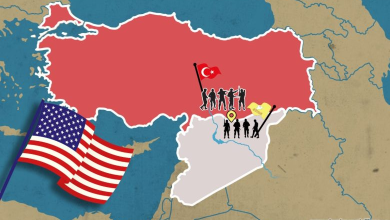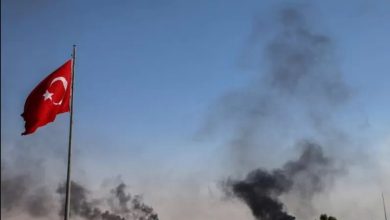
Economic and Strategic Implications of the Ongoing European Conflict Following the” Accession Treaty”
The main objective of Moscow’s launching a “military operation” against Ukraine on 24th of the last February was to take control of both the Ukrainian Luhansk and Donetsk regions.
Today, Moscow has finally annexed most of the eastern and southern regions of Ukraine to Russia after eight months of the war, following its control of these regions and conducting a popular referendum in them, which many observers described as a “Sham”, aiming at achieving many strategic, political, economic, commercial gains. This might have repercussions on the ongoing war and would strengthen the strategic and military position of Moscow in confronting Ukraine and its allied-Western countries against Russia.
The document signed by Russian President Vladimir Putin, according to which Moscow had completed the annexation of those areas to Russia, was called the “Treaty of Accession”. According to this document, Moscow has annexed approximately 65 thousand square km to its territory, which constitutes 20% of Ukraine’s territory, which Kyiv has lost today. Russia’s population has also increased by 8 million, while Kyiv has lost 21% of its population.
The various repercussions on the ground, whether political, economic, or strategic, will not be limited to Western States’ intensification of their sanctions on Moscow and the latter’s control of these provinces; because the issue goes far beyond that, whether in terms of the intros that have led to forming such situation on the ground, and the effects that could have on the course of the war, on the one hand, and in terms of indirect confrontations with the European countries, on both security and geopolitical levels, on the other hand.
Russia’s security and geopolitical gains
There is no need for great efforts to discover Russia’s real intentions for its annexation of these four regions into Russia; it would achieve crystal clear security and geopolitical gains by protecting its western border in the heated frontline against NATO and building up a safe zone that separates its real border away from the target of the western rockets. In addition, the military confrontation, this time, might lead to Russia’s upper hand after taking control of these regions, which would turn into the Russian military forces’ base from which they would launch their attacks on the Ukrainian Army, and this would be the least gains Russia can enjoy.
The crucial point here is the fact that Moscow was able to distance any danger coming from Ukraine into its territory, by annexing these regions, it denied the US access and use of these regions and the formation of military pressure on Moscow in this war. Subsequently, Russia was able to secure its western border and achieved, even ostensibly, its objective in this war after denying NATO to besiege and clamping down on it. Ukraine applied for accession to NATO in 2014 after the Nordic states had joined it. If the accession process had been done, the western border of Moscow would have been the target of NATO’s military bases directly.
Although the Donetsk and Luhansk regions experienced intensive battles at the beginning of the war, taking control over Zaporizhia and Kherson and their annexation to the Russian Federation was a Geo-military and strategic gain, especially since Kherson is linked to a land border with Crimea which was constituted a vulnerable point for Russia in this war. However, for the time being, the supply lines are open. Ukrainian forces can no longer intensify shelling or conduct military operations from Kherson since it is now under Russian control.
It is also worth mentioning that Russia’s declaration of these regions as “Russian territories has escalated confrontation against the Western countries and (NATO), and primarily Ukraine itself, since Moscow announced its readiness to defend its territories with every possible measure, and even by deadly weapons. This is how Russia has changed much of the military and geostrategic equation of the engagement roles on the ground, whether in its confrontation with the Ukrainian army or with its indirect confrontation with NATO.
The war of strategic interests
Nowadays, there is no ideological dispute among the conflicting parties in Europe; Russia is no longer operating as an anti-global capitalism power and is no longer in conflict with it on ideological foundations like the former soviet union was, rather, it has become part of this system. Russia’s strategic interests might differ from the western countries and the USA’s interests, especially since the latter is persistent to deal with Russia as a global opponent who seeks a collaboration with China to put an end to the unilateral status of the Global order that is spearheaded by the USA, and tries to harness all channels of trade and the global economy, to become at the service of its development and prosperity, or even to get out of its crises.
Obviously, the EU’s countries_ throughout the US’s continuous encouragement_ try to get rid of Russian energy products’ control despite the difficulty of such a move, whether in terms of securing alternative resources if there is any, especially Russsian Gas, or in terms of economic cost. In addition, Moscow controls, or at least, dominates most of the other supply lines that come from Central Asia’s countries, not to mention, it is almost complete control of the Black Sea basin and its navigation routes.
The US can no longer stand this issue, especially after oil high prices, and the viability of extracting its shale oil or exporting part of its Gas to EU countries. Therefore, the US tries to persuade its European partners, due to the Gas high price in EU countries and the Russian military threat on its eastern border, to depend on American Gas and other alternative sources perhaps would be more feasible for them, in order to get rid of Russia’s control, although of its high-cost access, which have nearly amounted to the Gas cost in Europe after this crazy war had broken out.
Russia is probably the wall that the Popular Republic of China protecting behind, the most powerful opponent for the US, therefore, it is possible to perceive this war, from this angle, as a war of attrition to the power and resources of this wall (Russia), whether militarily, by embroiling Russia in the Ukrainian swamp, after it had been embroiled in the Syrian swamp, or economically, throughout unprecedented sanctions that the global western system has rushed to impose it on Russia after launching its military operations in Ukraine, and it was not restricted to the economical aspect, as it used to be in imposing sanctions, and this, from our perspective, is a piece of evidence on the fact that main lines of this war had precisely been drawn, even not for so long before its beginning.
If you look into the Chinese stance on this war and how it has abstained to vote on a resolution in the security council that condemns Moscow’s annexation of four Ukrainian regions recently, you could figure out the fact that Beijing is fully aware that Russia, by its war, has contributed in achieving a significant part of its (China) strategic interests, especially not taking part into the war against the western system, on one hand, neither damaging its global trade routes, in particular, with the EU’s countries, on the other hand. Subsequently, neither it contributed to sanctions on Moscow, nor cut its commercial ties with it, especially the trade of Russian oil productions.
The attack logic is the best means to defend
Moscow’s annexation of these four regions from Ukraine means a great loss of the economic and human resources of Ukraine since it was a source of many resources for Ukraine on one hand, and the center of heavy industries, especially the metal industry in Luhansk and Donetsk, on the other hand. “ this would be a major blow for Ukraine, which had been feeding on Donbas area since last three decades” said, Denis Korkodinov, the Director of the International Center for Political Analysis and Forecasting based in Moscow.
According to the government’s Statistics Department in Ukraine, the contribution of these four regions (Donetsk, Luhansk, Kherson and Zaborizhia) to the Gross Domestic Production (GDP) of Ukraine have amounted to 10.8%, 3.6%, 1.6%, and 4% in a row in the late of 2020, which means the total loss of Ukraine has amounted to 20% of its (GDP), which has gone to the Russian Economy.
However, this fact will not lead to a complete benefit for Moscow; the new reality would impose additional burdens on the general budget, due to reconstruction imperatives and the rehabilitation of the infrastructures in these regions, which have witnessed violent military battles. In addition, Moscow would be obliged to provide humanitarian and medical aid for the inhabitants still over there, they had been affected by the war, and they should be provided with the public, educational and retirement services by Moscow due to their new legal status as Russian citizens, which would be obliged to implement many obligations for them.
By comparison, we can say, Moscow’s offensive plan, i.e. the annexation of these regions, even if it constitutes ostensibly running away forward, has led to Kyiv’s loss of one of its crucial economic sides and its export port and paralyzed its commercial shipping, whether in Azov Sea or Black sea towards Asia and the Middle East, especially Mariupol port. This plan will not be limited to economic impacts, but will also include military ones and the defense and offensive mechanisms of the Russian army against Ukraine.
Will European sanctions on Moscow pay off?
“It will pay an additional price for this escalation,” said Ursula von der Leyen, the president of the European Commission, and she had threatened and menaced Moscow soon later after the end of the referendum conducted by Russia to support separation from Ukraine. She also pointed out the EU’s readiness to impose “new and harsh sanctions” on Moscow, in a response to the annexation decision, which would include imposing further commercial restrictions, blacklisting individuals, and setting a cap on Russian oil prices.
The eight-month long of war has not proven the Europeans’ capability of inflicting further losses on Russia’s economy, as it did inflict on their own economy, nor proven their capability to manage the reality, in which imports of Russia’s Gas and Energy are reduced, the inflation rates have risen to unprecedented levels in the EU’s countries, and getting access to alternative resources have become a haunting concern for the European political leaders, especially after the US companies of Gas production and transportation have exploited the current situation and have risen its productions’ prices that surpassed fourfold the Russian Gas prices, for instance, this is why the French President stated: “We cannot pay the price of Gas fourfold more than the price you sell it to your manufacturers”, i.e. the US and Norway.
The continuation of such a situation could lead the European economy to a state of recession, due to high prices and the vulnerability of competitive capabilities because of energy high prices, which are accompanied by the European Central Bank’s high-interest rates due to high inflation levels. The continuation of this situation, undoubtedly, would lead to the rise of investment and production costs altogether, which in turn, would lead to high prices once again, subsequently more inflation, and economic and financial hurdles before the increase of investment volume.
This is a great challenge for Europe; it would result in employment and people’s income decrease who were used to a luxurious life. Therefore, in the light of the continuation of the recent economic and military situation and not thinking out of the box, away from the politicians’ plans and strategies in “Uncle Sam’s country, Europe could face political and social turmoil, which could mark the end of many of its regimes and states, and Ukraine is just the beginning.
Tremendous economic benefits for Russia’s “annexation decision”
Donpass region which includes both Luhansk and Donetsk provinces, constitutes the main industrial base for Ukraine, especially heavy and metal industries, which specialize in extracting metals and other metal crudes that are being used in different industrial activities. This region used to contribute from four to 5% of the industrial production in Ukraine, alongside its thermal and electrical energy and agriculture resources. By doing so, Russia would not only deprive Ukraine of these resources but also would provide many basic crude materials to Russian industries, whether military industries or space industries, these materials constitute preliminary elements into it, such as steel that is being used in making tanks, or some crudes that are being used in Russian Ballistic Missiles’ industry and spare parts, or its maintenance requirements.
Both regions of Luhansk and Donetsk contain an estimated 70% of Ukraine’s resources; they constitute the main center for Ukrainian industries and produce many agricultural crops, grains and corn; both they were forming 20% of the Ukrainian domestic production and were contributing 25% of total exports of Ukraine.
Another essential aspect is Russia’s control of more than 80% of the Ukrainian coast, especially the strategic huge port of “Mariupol” as the biggest port on the Azov Sea. By doing so, Russia has imposed maritime commercial isolation on Ukraine and has deprived it of the most important maritime commercial navigation port; Mariupol is the center of the iron and steel industry, and their exports, alongside coal and grains.
However, Russia’s control of Kherson gains economic significance due to its location over the Azov Sea, the Black sea, commercial navigation routes, and the main center for the vessel industry. Alongside its strategic significance, which is represented in its land border with Crimea.
It can be said that Russia achieved tremendous economic benefits by annexing these four regions to its territories, alongside strategic and military gains by seizing huge amounts of various economic resources, especially iron, steel and stone coalmines, the maritime and land commercial routs in eastern Ukraine to the Middle East and other regions of the world. However, this situation would impose on Russia more commitments towards those regions and their inhabitants; the administrative and economic authority in Russia would have to work on social issues and reorganize the economic life, would have to repair the affected infrastructure that had been destroyed by the war and rehabilitate it, which would cost Moscow, according to experts, more than 35 billion of dollars.
In conclusion, in spite of the economic and strategic gains that Moscow achieved after it had decided to annex these four regions, we can perceive this issue from other several angles: Firstly, this was a result of military operations, although Moscow attempted to legitimize it by adopting the rules of the legitimate referendum in those regions.
Secondly, this annexation decision of these regions could intensify the Ukrainian military operations against Russia’s army and its areas of control, especially Kyiv had accused all who participated in the referendum process of” Great Treason”. Subsequently, the military confrontations could intensify, and many rules of military engagement (human, moral, or international conflicts’ charter aspects) might fall.
Finally, it can be said that the EU’s countries and behind them, the US would raise the pace of their confrontation with Russia by pushing for tougher economic sanctions, or by increasing military support for Kyiv and supplying it with sophisticated ammunition and weapons, subsequently, increasing the severe violence while military confrontations, which would lead to more human casualties and economic losses for different participated parties of this war, whether those directly involved(Russia and Ukraine), or those indirectly involved, especially(the EU’s countries), while, the US stays away far from the ongoing military conflict location, but it is so close to the economic conflict, in which it leads it in favor of its major corporations and institutions.





